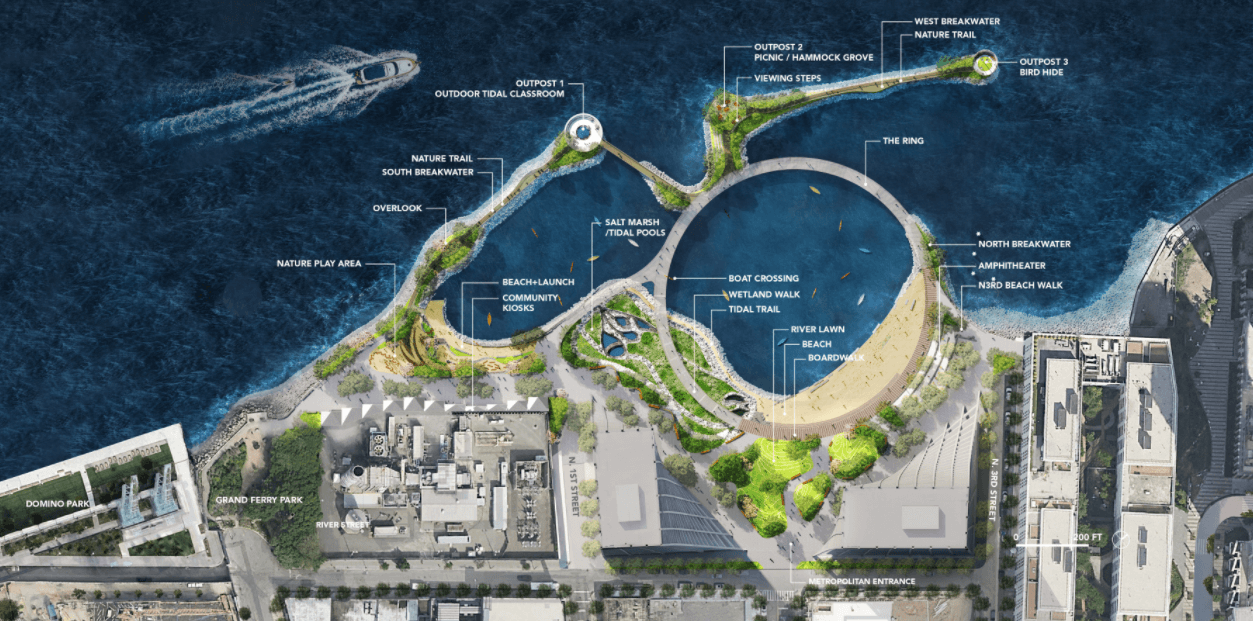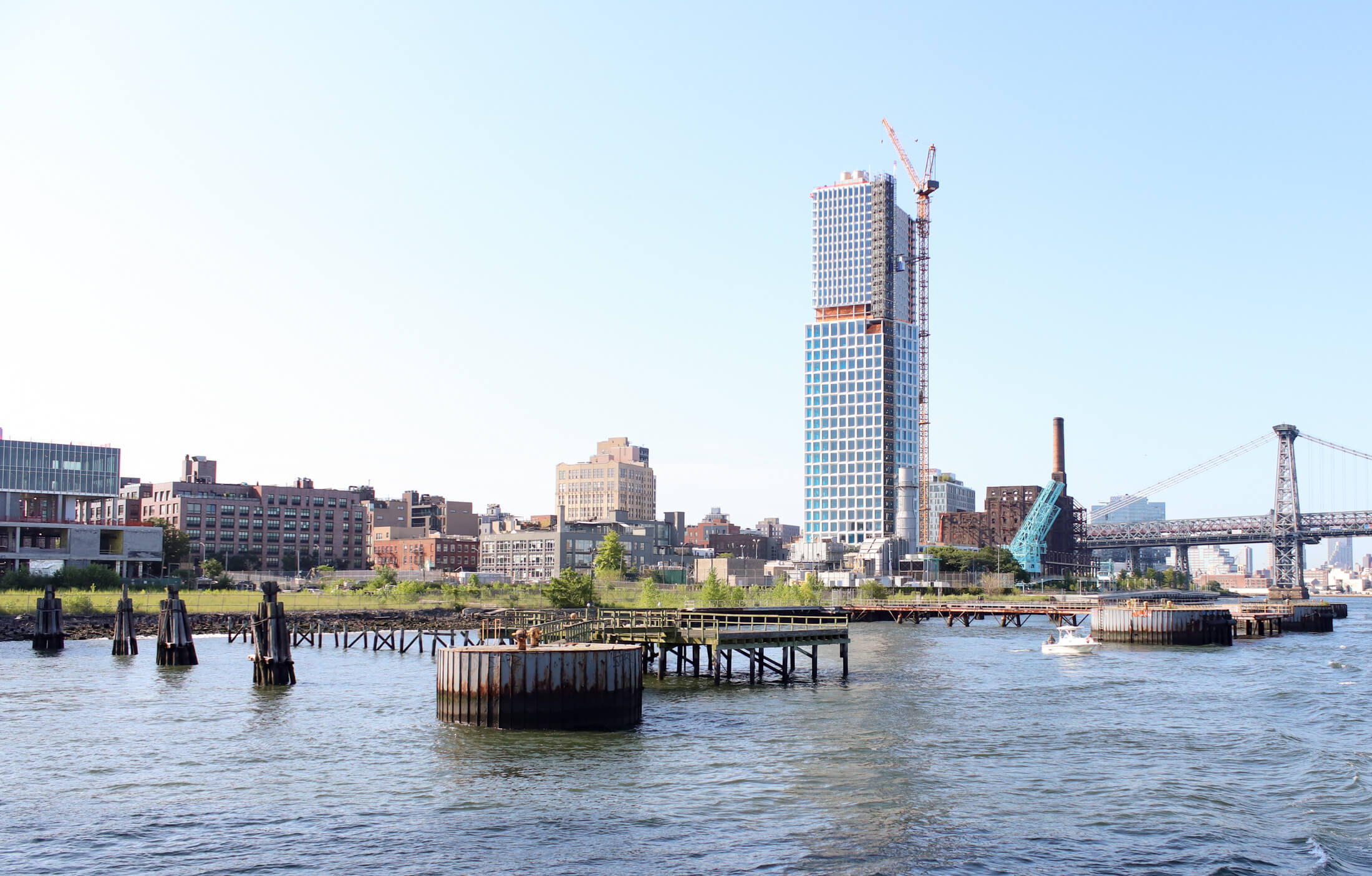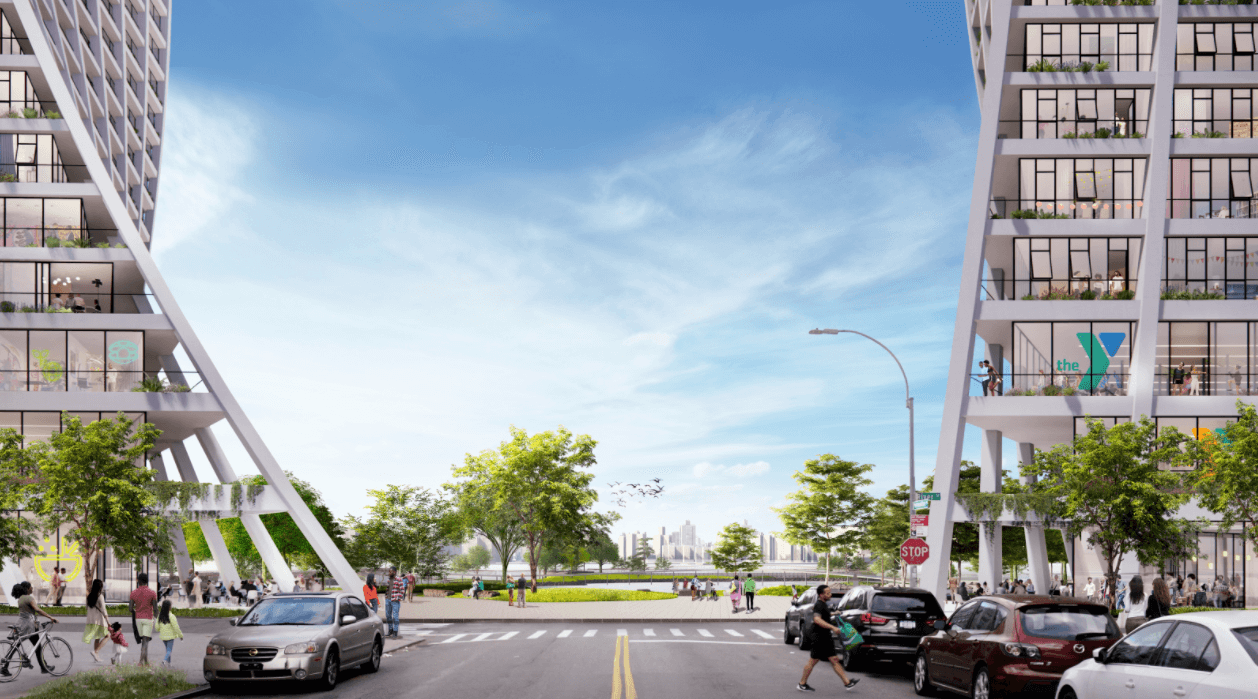Local Community Groups Voice Tentative Support for Williamsburg Towers, With Some Caveats
After months of loud community criticism, three local nonprofits have voiced their tentative support for the waterfront development.

Rendering by James Corner Field Operations and BIG-Bjarke Ingels Group
After months of loud community criticism over a pair of proposed waterfront towers in Williamsburg, three local nonprofits have voiced their preliminary support for the waterfront development — giving Two Trees Management a boost of much-needed help ahead of the contentious rezoning process.
“Los Sures, El Puente, and St. Nicks Alliance, the Coalition, have long been advocates for affordable housing, jobs and environmental justice,” the letter reads. “Together, along with many other organizations, we continue to advocate for the interest of low- and moderate-income residents in our community. We appreciate the efforts of Two Trees community engagement over the last nine years and now towards the development of the River Ring Project.”
The coalition is “grateful” to have been consulted in matters of affordable housing, local job creation and environmental equity, the letter says.
They also believe the project can be improved, and included some requests directed at Two Trees.
“Right now, we’re not taking a position on the proposed project,” said Marco A. Carrión, executive director at El Puente. “Our organization has been convening environmental justice partners and folks directly impacted by the project, or potentially impacted by the project, to identify any features and benefits the project must contain before we can potentially support it.”

Ten years ago, El Puente, a youth-focused organization founded in response to high rates of violence in south Williamsburg, started the Green Light District project.
“It was a ten-year program meant to look at creating a stable community for the folks that we serve, which are mostly Puerto Rican, Dominican, and African-American members on the south side of Williamsburg,” Carrión said. “Looking at issues including air quality, arts and cultural preservation, public safety, green space.”
From the Green Light District came Our Air, a project focused on studying and pushing for improvements in air quality in Bushwick and Williamsburg, where both child and adult asthma rates are higher than average rates across Brooklyn and New York City as a whole.
The letter asks that Two Trees not just focus on the ecological impact of the physical site River Ring sits on, but the air quality and temperatures in the neighborhood, using greenery and air-purifying trees both on the site and on heavily trafficked streets around it.
El Puente is staffed by community members, Carrión said, and endeavors to speak with them on the issues that really matter. As the conversation about River Ring got louder, he and his colleagues decided they had to be part of the development process.
“Our history is really one of direct action,” he said. “But that’s not our first move. Our first move is open ears, willing to talk, just be honest with us so that we can move accordingly.”
“It’s time for people to show their cards on where they stand on the project,” said David Lombino, a Two Trees spokesman, when asked if the company had sought support. “Neighborhood entities, this is when they would step forward and say what they think. It’s not an issue of encouraging them or not, it’s more, this is the time.”

The Workforce Development Center at St. Nicks Alliance has a long history with Two Trees, said program director Larry Rothchild. When their construction training program was launched in 2016, they sought community partners to provide hands-on training and help build the curriculum.
That partnership led to 90 people from the training program landing jobs at the Domino Sugar Refinery redevelopment, and more being hired at Domino Park as urban greenscapers.
“When we started with Two Trees, they were paying much lower,” Rothchild said. “We really are trying to push for sustainable wages, living wage and career growth. So we worked with Two Trees and they now start at $20 an hour.”
In the letter, the coalition asks for a promise of 100 construction jobs at $20 per hour, along with at least 100 permanent jobs once the site is finished. Those could be in maintenance once the buildings are done, Rothchild said, or in the retail shops that will populate parts of the development.
“There could be developers who come to us to advocate for them when they’re getting approval, but then they never follow through,” Rothschild said. “So I do think people should be aware that this is creating jobs and opportunity, and this is an employer that’s helping people stay in their communities.”
The coalition also asked for a significant increase in affordable housing available in the two buildings. Two Trees plans to include 263 affordable units, including 27 units available at 40 percent of the area median income, as part of Mandatory Inclusionary Housing. In the letter, the coalition asks that the company consider increasing the number of affordable apartments above 25 percent, with at least 20 percent priced for 40 percent AMI.

River Ring’s website notes that they are open to speaking with the community about increasing the number of affordable apartments.
As the coalition seeks to shape both the construction process and the permanent legacy of the development in the form of permanent jobs and affordable apartments, Carrión said it’s also important to ensure that the public park space is not only accessible to the entire community but welcoming, especially for long-term residents dealing with gentrification.
“For these folks, they not only deal with the fact that rising rents have made a lot of their neighbors leave the area, but also whatever their cultural touchstones were in this neighborhood — where they went to shop for food, for clothing, where they went to the movies, where they hung out — all those places have closed down,” he said.
“A big thing for us is art for social change, but also remembering that art is a very powerful tool to signal to folks who they are, where they are, and if they belong. Whose neighborhood is it? If you have art up, if you’re having people perform music or dance, or what have you, we ask that those things speak to a wider universe.”
Editor’s note: A version of this story originally ran in Brooklyn Paper. Click here to see the original story.
Related Stories
- Massive Bjarke Ingels-Designed Williamsburg Development Kicks Off Public Review
- Environmentally Themed Mini Golf, Farm Headed to Two Trees’ Williamsburg Waterfront Site
- Two Trees’ Proposal for Curved Towers, Beach on Williamsburg Waterfront Returns
Email tips@brownstoner.com with further comments, questions or tips. Follow Brownstoner on Twitter and Instagram, and like us on Facebook.





What's Your Take? Leave a Comment